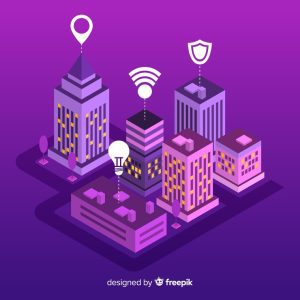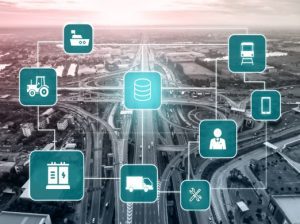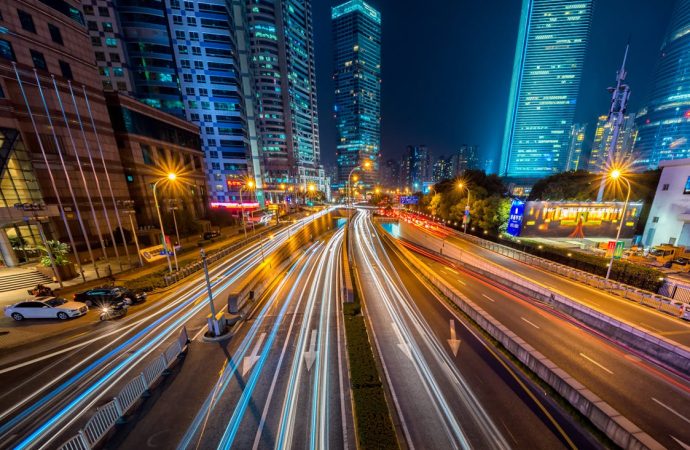The idea of “smart cities” has become a revolutionary way to live in cities. These cities use technology and data to make people’s lives better and make cities more environmentally friendly. Cities around the world are facing problems like environmental problems, rapid population growth, and more people living in cities. They need new ideas to solve these problems more than ever. This piece talks about the future of smart cities by looking at the newest ideas, their advantages, and the problems that need to be solved in order to make this vision come true. What Do Smart Cities Actually Mean? Smart cities use technology, data, and new ways of doing things to make city processes more efficient, improve public services, and get people involved. When Internet of Things (IoT) devices, artificial intelligence (AI), and big data analytics are all used together, city resources can be managed and watched in real time.
The idea of “smart cities” has become a revolutionary way to live in cities. These cities use technology and data to make people’s lives better and make cities more environmentally friendly. Cities around the world are facing problems like environmental problems, rapid population growth, and more people living in cities. They need new ideas to solve these problems more than ever. This piece talks about the future of smart cities by looking at the newest ideas, their advantages, and the problems that need to be solved in order to make this vision come true.
What Do Smart Cities Actually Mean?
Smart cities use technology, data, and new ways of doing things to make city processes more efficient, improve public services, and get people involved. When Internet of Things (IoT) devices, artificial intelligence (AI), and big data analytics are all used together, city resources can be managed and watched in real time. This helps people make better decisions and lives better in cities.
New ideas are making smart cities possible.

Image by Freepik.com
1. IoT and Connected Infrastructure
The core of smart city infrastructure is made up of Internet of Things (IoT) gadgets. Sensors put into roads, buildings, and public areas gather information about everything from air quality to traffic patterns. With this information, city leaders can make better decisions about how to use resources and improve public services.
Case Study: Barcelona, Spain
Barcelona has set up a large network of sensors and Internet of Things (IoT) devices that keep an eye on many parts of city life. For example, smart trash cans with sensors let you know when they need to be cleared, which cuts down on pick-ups that aren’t needed and saves money on waste management costs. Smart traffic lights also change based on the flow of traffic in real time, which reduces traffic jams and shortens travel times.
2. Easy to Use Transportation

Image by Yandex.com
Transportation innovations are very important to the future of smart towns. Smart transportation systems include self-driving cars, tracking of public transit in real time, and mobility solutions that connect different types of transportation.
Example: Singapore
Singapore’s smart transportation system uses real-time data analytics to manage traffic flow effectively. The Land Transport Authority (LTA) has developed a comprehensive network of sensors and cameras that monitor traffic conditions. The data collected is used to optimize traffic signals, provide real-time updates to commuters, and enhance public transport scheduling. Moreover, Singapore is actively testing autonomous vehicles to further improve urban mobility.
3. Energy Efficiency and Sustainability
Sustainable energy solutions are at the forefront of smart city innovations. From renewable energy sources to smart grids, cities are increasingly focusing on reducing their carbon footprint and enhancing energy efficiency.
Case Study: San Diego, California
San Diego is a leader in solar energy implementation, boasting one of the highest rates of solar panel installations in the United States. The city has also developed a smart grid system that allows for better management of energy distribution, incorporating renewable energy sources. By using data analytics, San Diego can predict energy demand and optimize supply, significantly reducing reliance on fossil fuels.
4. Smart Water Management

Image by Yandex.com
Water scarcity is a growing concern for urban areas worldwide. Smart water management systems utilize sensors and data analytics to monitor water usage, detect leaks, and ensure efficient distribution.
Example: Amsterdam, Netherlands
Amsterdam has implemented smart water management solutions that track water quality and consumption in real-time. The city uses advanced metering infrastructure (AMI) to monitor water usage patterns and detect leaks promptly. This proactive approach not only saves water but also reduces operational costs for the city.
5. Public Safety and Security
Innovations in public safety are vital for creating safer urban environments. Smart cities are utilizing advanced surveillance systems, predictive analytics, and community engagement platforms to enhance security.
Case Study: New York City, USA
New York City has adopted a range of smart technologies to improve public safety. The NYPD employs predictive policing algorithms that analyze crime data to identify hotspots and allocate resources effectively. Additionally, the city has expanded its surveillance network, integrating real-time video feeds to monitor public spaces and respond quickly to incidents.
Benefits of Smart Cities
The transition to smart cities offers numerous benefits that enhance urban living:
1. Improved Quality of Life
Smart cities prioritize the needs of residents, offering improved services, efficient public transport, and enhanced public spaces. Access to real-time information empowers citizens to make informed decisions about their daily activities.
2. Environmental Sustainability
By adopting innovative technologies, smart cities can reduce their carbon footprint and promote sustainable practices. From energy-efficient buildings to smart waste management, cities can minimize environmental impact while meeting the needs of their populations.
3. Economic Growth

Image by Yandex.com
The integration of technology into urban infrastructure fosters innovation and attracts businesses. Smart cities create an ecosystem conducive to economic growth, job creation, and improved services, making them attractive locations for investment.
4. Enhanced Public Safety
Smart technologies contribute to safer urban environments through improved surveillance, efficient emergency response systems, and data-driven policing strategies. Citizens benefit from reduced crime rates and increased confidence in public safety measures.
Challenges Facing Smart Cities
While the potential of smart cities is immense, several challenges must be addressed to ensure successful implementation:
1. Data Privacy and Security
The extensive use of sensors and data collection raises concerns about privacy and data security. Smart cities must implement robust data protection measures to safeguard citizens’ information from breaches and misuse.
2. Digital Divide
The benefits of smart cities must be accessible to all residents, including those from marginalized communities. Ensuring equitable access to technology and services is essential to avoid exacerbating social inequalities.
3. High Implementation Costs
The transition to smart city infrastructure often requires significant investment. Cities must find ways to fund these initiatives while balancing other pressing urban needs, such as affordable housing and education.
4. Incorporation of Legacy Systems
Many cities operate with outdated infrastructure that may not be compatible with new technologies. Successfully integrating legacy systems with modern solutions poses a considerable challenge for urban planners and policymakers.
Final Thought
The future of smart cities is promising, propelled by breakthrough technologies that aim to improve urban living, foster sustainability, and encourage economic growth. Nonetheless, actualizing this vision necessitates meticulous contemplation of the obstacles that accompany these breakthroughs. By emphasizing data privacy, guaranteeing equal access, and investing in infrastructure, communities may cultivate ecosystems that genuinely benefit all inhabitants. The future development of smart cities will rely on cooperation among governments, enterprises, and communities to create a sustainable and inclusive urban environment.
















